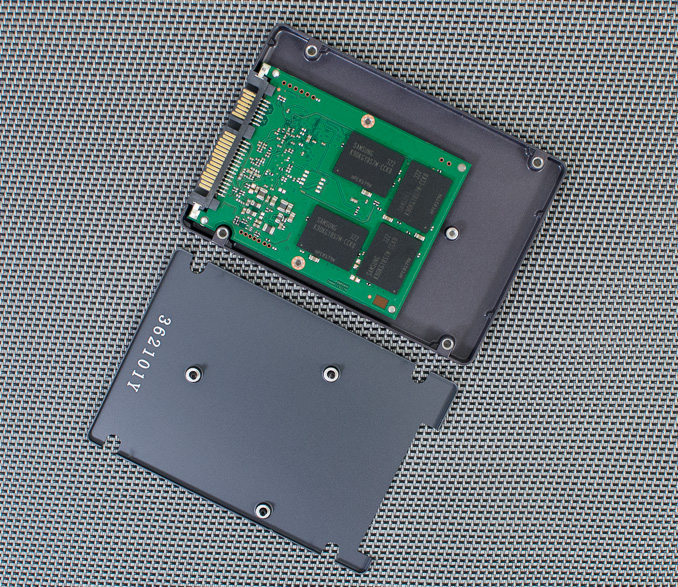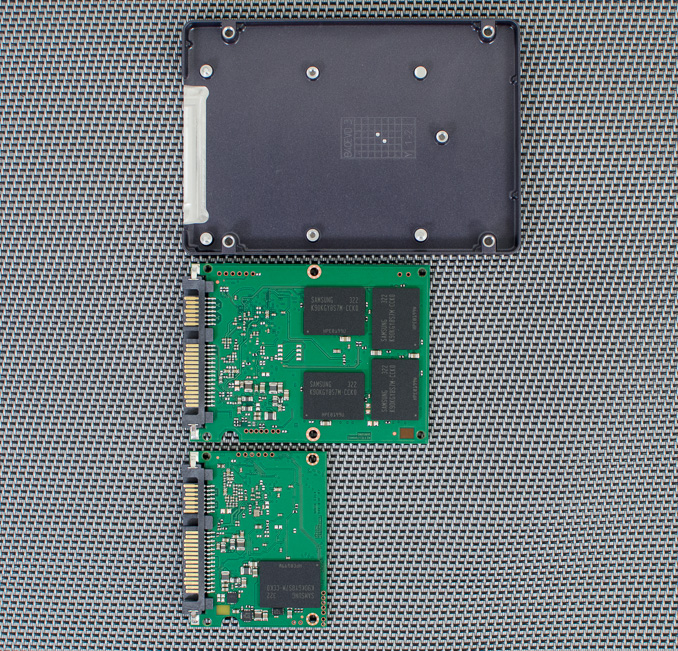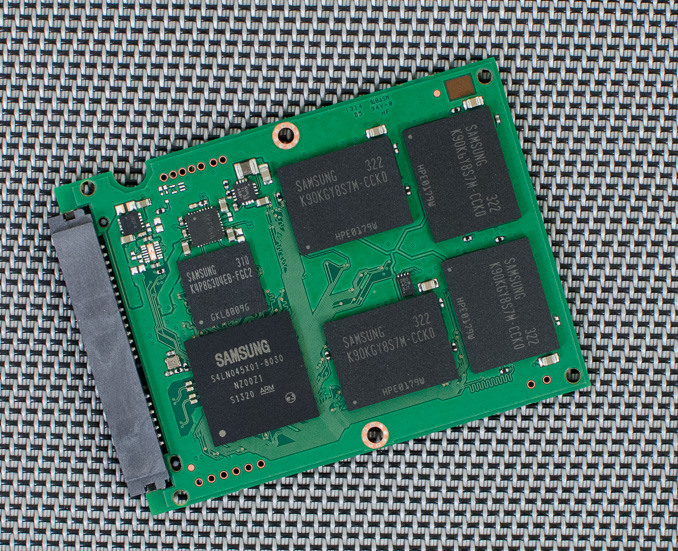Samsung SSD 840 EVO Review: 120GB, 250GB, 500GB, 750GB & 1TB Models Tested
by Anand Lal Shimpi on July 25, 2013 1:53 PM EST- Posted in
- Storage
- SSDs
- Samsung
- TLC
- Samsung SSD 840
Inside the Drives & Spare Area
The EVO is offered in a single form factor - 2.5" at a 7mm thickness. There are three torx (T5) screws that hold the chassis together, removing them gets you a look at the EVO's very simple internals. Surprisingly enough there's no thermal pad between Samsung's MEX controller and the chassis.
Samsung, like Intel, does a great job of reducing the number of screws and simplifying the assembly of its drives. I would prefer if Samsung didn't insist on using torx screws to hold the chassis together but I'm sure it does have some impact on reducing returns. There's also growing concern of counterfit SSDs which I guess screw choice could somewhat address.
There are two PCB sizes used in the EVO lineup, neither of which occupies the full volume of the 2.5"/7mm chassis. The 120 and 250GB drives use the smallest PCB, while the other drives use the larger layout. The larger PCB has room for 8 NAND packages, while the half length PCB can accommodate two. Each of the NAND packages can hold up to 8 x 128Gbit 19nm TLC die.
To deal with the realities of TLC, Samsung sets aside more of the drive for use as spare area on the EVO than it does on its MLC Pro line. Due to TurboWrite however, the percentage is actually a bit less than it was on last year's 840.
| Samsung SSD 840 EVO Memory | |||||||
| Advertised Capacity | 120GB | 250GB | 500GB | 750GB | 1TB | ||
| DRAM Size | 256MB LPDDR2-1066 | 512MB LPDDR2-1066 | 512MB LPDDR2-1066 | 1GB LPDDR2-1066 | 1GB LPDDR2-1066 | ||
| # of NAND Packages | 2 | 2 | 4 | 8 | 8 | ||
| # of NAND die per Package | 4 | 8 | 8 | 4 | 8 | ||
| NAND Capacity per Package | 64 GiB | 128 GiB | 128 GiB | 96 GiB | 128 GiB | ||
| Total NAND | 128 GiB | 256 GiB | 512 GiB | 768 GiB | 1024 GiB | ||
| Spare Area | 12.7% | 9.05% | 9.05% | 9.05% | 9.05% | ||
I've tossed internal shots of all of the EVO lineup into the gallery below:



















137 Comments
View All Comments
Grim0013 - Sunday, July 28, 2013 - link
I wonder what, if anything, the impact of Turbo Write is on drive endurance, as in, does the SLC buffer have the effect of "shielding" the TLC from some amount of write amplification (WA)? More specifically, I was thinking that in the case of small random writes (high WA), many of them would be going to the SLC first, then when the data is transferred to the TLC, I wonder if the buffering affords the controller the opportunity to write the data is such a way as to reduce WA on the TLC?In fact, I wonder if that is something that is done...if the controller is able to characterize certain types of files as being likely the be frequently modified then just keep them in the SLC semi-permanently. Stuff like the page file and other OS stuff that is constantly modified...I'm not very well-versed on this stuff so I'm just guessing. It just seems like taking advantage of SLCs crazy p/e endurance in addition to it's speed could really help make these things bulletproof.
shodanshok - Sunday, July 28, 2013 - link
Yea, I was thinking the same thing. After all, Sandisk already did it on the Ultra Plus and Ultra II SSDs: they have a small pseudo-SLC zone used both for greater performance and reducing WA.shodanshok - Sunday, July 28, 2013 - link
I am not so exited about RAPID: data integrity is a delicate thing, so I am not so happy to trust Samsung (or others) replacing the key well-tested caching algorithm natively built into the OS.Anyway, Windows' write caching is not so quick because the OS, by default, flush its in-memory cache each second. Moreover, it normally issue a barrier event to flush the disk's DRAM cache. This last thing can be disabled, but the flush of the in-memory cache can not be changed, as far I know.
Linux, on the other side, use much aggressive caching policy: it issue an in-memory cache flush (pagecache) ever 30 seconds, and it aggressively try to coalesce multiple writes into a single transactions. This parameter is configurable using the /proc interface. Moreover, if you have a BBU or power-tolerant disk subsystem, you can even disable the barrier instruction normally issued to the disk's DRAM cache.
Timur Born - Sunday, July 28, 2013 - link
My Windows 8 setup uses quite exactly 1 gb RAM for write caching, regardless of whether it's writing to a 5400 rpm 2.5" HD, 5400 rpm 3.5" HD or Crucial M4 256 gb SSD. That's exactly the size of the RAPID cache. The "flush its cache each second" part becomes a problem when the source and destination are on the same drive, because once Windows starts writing the disk queue starts to climb.But even then it should mostly be a problem for spinning HDs that don't really like higher queue numbers. Even more so when you copy multiple files via Windows Explorer, which reads and write files concurrently even on spinning HDs.
So I wonder if RAPID's only real advantage is its feature to coalesce multiple small writes into single big ones for durations longer than one second?!
Timur Born - Sunday, July 28, 2013 - link
By the way, my personal experience is that CPU power saving features, as set up in both in the default "Balanced" and the "High Performance" power-profiles, have far more of an impact on SSD performance than caching stuff. I can up my M4' 4K random performance by 60% and more just by messing with CPU power savings to be less aggressive (or off).shodanshok - Monday, July 29, 2013 - link
If I correctly remember, Windows use at most 1/8 of total RAM size for write caching. How much RAM did you have?Timur Born - Tuesday, July 30, 2013 - link
8 gb, so you may be correct. Or you may mix it up with the 1/8 part of dirty cache that is being flushed by the Windows cache every second. Or both may be 1/8. ;-)zzz777 - Monday, July 29, 2013 - link
I'm interested in caching writes to a ram disk then to storage. This reminds me if the concept of a write-back cache: for almost everyone The possibility of data corruption is so low that there's no reason not to enable it: can this ssd ramdisk write quickly enough that home users also don't have to worry about using it? Beyond that I'm not a normal home user, I want to see benchmarks for virtualization, I want the quickest way to create, modify and test a vm before putting it on front life hardwareWwhat - Monday, July 29, 2013 - link
I for me still say: I rather go for the pro version.andreaciri - Thursday, August 1, 2013 - link
i have to decide if buy an 840 now, or an EVO when it will be available, for my macbook. considering that RAPID technology is only supported under windows, and that i'm more interested in read performance than write, is 840 a good choice?